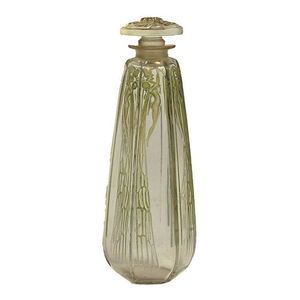Yabu Meizan Satsuma Vase with Iris and Dragonfly
You must be a subscriber, and be logged in to view price and dealer details.
Subscribe Now to view actual auction price for this item
When you subscribe, you have the option of setting the currency in which to display prices to $Au, $US, $NZ or Stg.
- Gilding - Gilding is a method of ornamentation whereby a thin sheet of gold metal is applied to items made of wood, leather, ceramics, glass and silver for decorative purposes.
For furniture including mirrors, the sheet of gold is usually applied over a coating of gesso. Gesso is a mixture of plaster of Paris and gypsum mixed with water and then applied to the carved wooden frames of mirrors and picture frames as a base for applying the gold leaf. After numerous coats of gesso have been applied, allowed to dry and then sanded a coat of "bole", a usually red coloured mixture of clay and glue is brushed on and allowed to dry, after which the gold leaf is applied. Over time parts of the gilding will rub off so the base colour can be seen. In water gilding, this was generally a blue colour, while in oil gilding, the under layer was often yellow. In Victorian times, gilders frequently used red as a pigment beneath the gold leaf.
Metal was often gilded by a process known as fire gilding. Gold mixed with mercury was applied and heated, causing the mercury to evaporate, the long-term effect of which was to kill or disable the craftsman or woman from mercury poisoning. The pursuit of beauty has claimed many victims, not the least of which were the artists who made those pieces so highly sought after today. - Earthenware - A basic ceramic material that is fired at a low temperature. Earthenware is the basis of almost all ancient, medieval, Middle Eastern and European painted ceramics. After firing, the colour is the colour of the clay when it is dug from the ground: buff, brown and red. It is not waterproof until glazed. Creamware is a type of earthenware covered with a transparent lead glaze. Majolica, faience and delft are also earthenware covered in an opaque white tin glaze.
This item has been included into following indexes:
Visually similar items

A Martin Brothers stoneware flying ducks tall slender jug, incised 2-1897 Martin Bros. London & Southall. 21 cm high

An Etablissement Galle 'Iris' cameo glass vase, French, circa 1910, the teardrop body with an acid-etched design, in shades of blue on a frosted pale yellow ground, acid-etched 'Galle, 24 cm high. Provenance: Mr Hans Mueller and Mrs Gertrud Mueller, Sydney

Muller Croismare cameo glass vase on a pink ground with a green single stem plant overlay, inscribed 'Muller Croismare'. Condition good, factory flaw to the base. Height 45 cm

A good Rene Lalique 'Cyclamen' scent bottle of tall tapered hexagonal form with embossed decoration of a naked woman with long cicada wings, green stained highlights, the oval convex stopper with scroll moulded relief detail to the top, moulded signature t
